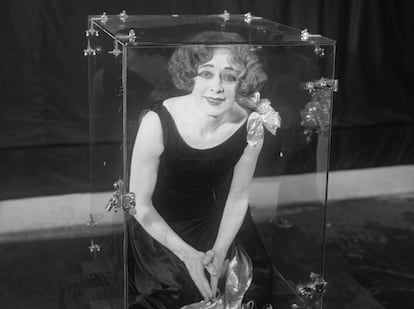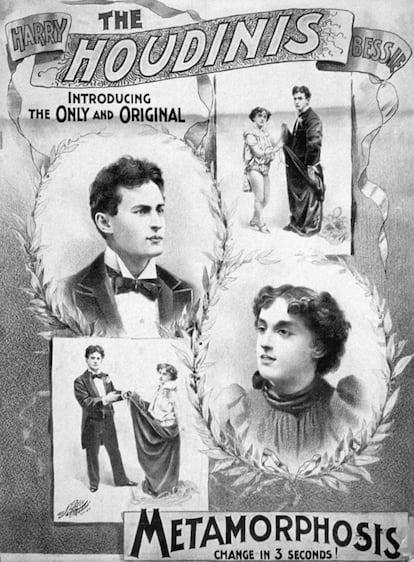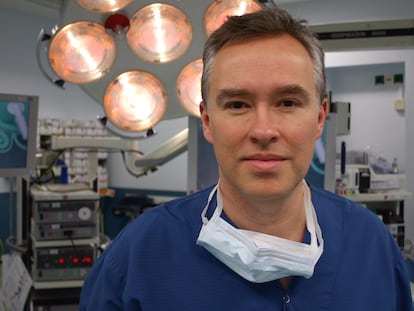The secrets of Bess Houdini, the magician’s wife who knew his escapist tricks
Her crusade to unmask the charlatans of spiritualism—part real and part spectacle—still has a very special place in 20th century American culture

“Ten years is long enough to wait for any man,” Beatrice “Bess” Houdini told TIME magazine shortly before her death. Without a doubt, this is the phrase by which the widow of the famous Austro-Hungarian illusionist and escape artist Harry Houdini will always be remembered. The legendary magician was the love of her life, and death unexpectedly took him away from her despite the fact that his life had been at risk on thousands of occasions. After his death, she waited for him for 10 years, trying unsuccessfully to contact him by all possible means.
Harry Houdini’s death continues to be the subject of debate among conspiracy theorists and mystery fans. The most famous escape artist in history (with apologies to David Copperfield) died in 1926, supposedly after taking a series of heavy blows to the stomach for which he was not prepared. A furious enemy of phony spiritualists (who were almost as common then as they are now), he and Bess had an agreement that if he died before she did, they would try to make contact through séances. To verify the communication’s veracity, they established a password: “Rosabelle - answer - tell - pray, answer - look - tell - answer, answer – tell.” This strange series of words came from a secret code created by magicians to communicate with their assistants during their mentalism acts. Each word, or group of words, corresponded to a letter. For example, the word “answer” was the letter B, “answer-answer” was the letter V, etc. The code the Houdinis chose meant “Believe.” But Harry never transmitted that message to Bess from the great beyond.

The beginnings of a unique couple
The first word of the message, “Rosabelle,” referred to the song Bess sang when she and Harry met when they were performing in a theater in Coney Island, New York. At the time, he was 20 and she was only 18; they were just aspiring performers. Harry’s brother Theo first courted Bess, but Harry eventually married her in June 1894. Bess was born Wilhelmina Beatrice Rahner in Brooklyn to a family of German immigrants, and from an early age she felt the call of show business. She started out singing in a group called The Floral Sisters. After marrying Harry, she began to work with him; she did tricks herself and helped him as his assistant in an act called The Houdinis.
At the turn of the century, after changing managers, Harry started to achieve success. After focusing on escapism—the most spectacular part of his act—he soon gained international fame and toured not only the United States but also Europe. Once this happened, Bess decided to take a step back. She only rarely went on stage and helped out backstage by advising her husband on his tricks and taking care of his wardrobe.
Throughout their relationship, the Houdinis remained a close couple. There are many photos of the two together, and, as the magician’s biographer Kenneth Silverman explains in his book Houdini!!!! The Career of Erich Weiss, Harry often left very affectionate notes for Bess in which he called her a “Precious Lump of Sweetness” and “Sweetie Wifie, Mine,” and signed them with names like “your popsy” and “Houdinsky.” As their niece Marie Blood explained in a 1995 interview, they adored children but were never able to have one because Bess suffered from primary amenorrhea and could never get pregnant.

Harry Houdini’s death
Although he had walked the razor’s edge all his life, Houdini’s death was unexpected and was a devastating blow for Bess. After the famed magician died, Bess experienced problems with money, alcohol and the thousands of charlatans who approached her to get her money by promising that they could contact Harry in the afterlife. For years, Bess was faithful to the promise that she had made to her husband and periodically held seances, futilely hoping that Harry would appear and say the words that they had agreed upon. The fact that it never happened plunged her into such despair that she attempted suicide twice.
In 1930, in the midst of all this, she met Edward Saint, who became her manager and perhaps something more (although it has never been proven). They moved to Hollywood together, and Bess dedicated herself to keeping her husband’s memory alive. After 10 years of trying to talk to him, in 1936 Bess and Saint organized The Final Seánce on the terrace of Hollywood’s Knickerbocker Hotel on Halloween; for the final time, she attempted to summon Harry’s spirit. The surviving photos from the event, which appear on the Wild About Harry blog, are truly spooky and quite a spectacle in and of themselves. The ceremony also had a bit of a stage play and was an extraordinary publicity campaign (we’ll see why later).
As expected, the illusionist did not appear, and his widow gave up the quest that, years later, inspired the phrase with which this text begins. Nevertheless, Bess entrusted her friend Walter B. Gibson—the writer of the mystery series The Shadow and Houdini’s friend, confidant, publicist and ghostwriter—to continue holding an annual session to try to contact the magician. The Wild About Houdini blog contains the dialogue between Bess and Saint, her manager, at the end of the last seance. Quoting it at length gives one a sense of the moment’s theatricality.
Saint: Mrs. Houdini. The zero hour has passed. The ten years are up. Have you reached a decision?
Bess: Yes. Houdini did not come through. My last hope is gone. I do not believe that Houdini can come back to me, or to anyone. After faithfully following through the Houdini ten year compact, after using every type of medium and seance, it is now my personal and positive belief that spirit communication in any form is impossible. I do not believe that ghosts or spirits exist. The Houdini shrine has burned for ten years. I now reverently turn out the light. It is finished. Good night, Harry.
Over time, the Final Seánce has become something of a cliché in the American spiritualist world, and sessions honoring the legendary magician are still held today in many places around the United States, including the Houdini Museum in Scranton, Pennsylvania (yes, the town where The Office is set).

The Final Years
Bess and Saint put the publicity of The Final Seánce to good use. The following year they sold Paramount the rights to make a biopic about Harry, a project that took almost 20 years to complete; it starred Tony Curtis and Janet Leigh in the roles of the magician and Bess. Interest in the couple’s story and their stance on parapsychology was such that Bess also shot her own film the following year. It was originally to be titled Madame Houdini Speaks. The idea was that, after 10 years of silence imposed by the search for her husband among the spirits, Bess was going to discuss her views on spiritualism but in a fictional movie.
The film—which was originally released as Religious Racketeers and then later changed its title back to Mystic Circle Murder—finally premiered in 1938. In it, Bess only appeared at the beginning and at the end; she played herself, and her participation essentially consisted of declaring that communication with the dead was simply impossible. As we can see in these images, her words were basically a reworking of what she had said on the terrace of the Knickerbocker Hotel a few years earlier. The film had an impact on spiritualist circles, which obviously felt attacked by it, but other than that it went largely unnoticed (it was almost always shown as part of a double feature). In fact, the film was almost lost altogether. As far as we know, only one copy survived—in it, almost all of Bess’s final speech has been cut—and it was released on DVD in 2006.
Bess Houdini’s death
There is little additional information about Bess’s life from this point until her death five years later, on February 11, 1943. Bess, who had been very weak for some time and was probably suffering from tuberculosis, had a stroke while traveling by train from Los Angeles to New York to “spend her final days with her family,” the local press wrote at the time. She was 67 years old.
Sign up for our weekly newsletter to get more English-language news coverage from EL PAÍS USA Edition
Tu suscripción se está usando en otro dispositivo
¿Quieres añadir otro usuario a tu suscripción?
Si continúas leyendo en este dispositivo, no se podrá leer en el otro.
FlechaTu suscripción se está usando en otro dispositivo y solo puedes acceder a EL PAÍS desde un dispositivo a la vez.
Si quieres compartir tu cuenta, cambia tu suscripción a la modalidad Premium, así podrás añadir otro usuario. Cada uno accederá con su propia cuenta de email, lo que os permitirá personalizar vuestra experiencia en EL PAÍS.
¿Tienes una suscripción de empresa? Accede aquí para contratar más cuentas.
En el caso de no saber quién está usando tu cuenta, te recomendamos cambiar tu contraseña aquí.
Si decides continuar compartiendo tu cuenta, este mensaje se mostrará en tu dispositivo y en el de la otra persona que está usando tu cuenta de forma indefinida, afectando a tu experiencia de lectura. Puedes consultar aquí los términos y condiciones de la suscripción digital.
More information
Archived In
Últimas noticias
Welcome to the post-religion era: The idea of Christianity as the absolute truth has become obsolete
‘I thought you would like it’: The risky sexual practice popularized by TV shows and TikTok
The digitalization of tourism: ‘They promise experiences and gave us the worst possible one’
Mexican peso defies uncertainty with forecasts of a new period of stability in 2026
Most viewed
- Sinaloa Cartel war is taking its toll on Los Chapitos
- Reinhard Genzel, Nobel laureate in physics: ‘One-minute videos will never give you the truth’
- Oona Chaplin: ‘I told James Cameron that I was living in a treehouse and starting a permaculture project with a friend’
- Why the price of coffee has skyrocketed: from Brazilian plantations to specialty coffee houses
- Silver prices are going crazy: This is what’s fueling the rally










































